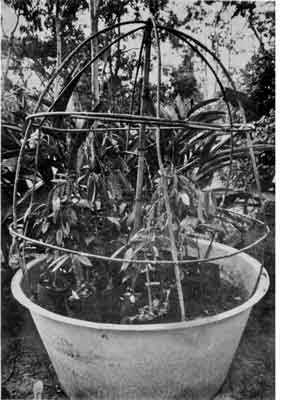
FITZROY TANK
1.Base Fibreglass, galv. iron etc. Preferably circular, approximately 500-800 mm high and open-bottomed.
2. Fill - Half soil - half sawdust (or bagasse) or all sawdust to about 400 mm.
Place - Preferably on concrete floor, ensure sawdust is thoroughly wet.
Tank should have a collar to enable a rope to be fastened to hold the plastic sheet to the tank. Galvanized iron tanks have this anyway.
The top of the tank should have a frame made of either light-gauge wire, or lawyer cane is ideal, preferably bee hive shape, preferably 1.5 m high or more.
3. Cover with heavy polythene (clear). Prefer one-piece or joined well.
4. Long enough to lap over the tank itself then tie to tank with rope.
5. Shade should be at least 100% - be careful of west wall.
6. Stocks - young, vigorous, preferably 400 to 600 mm high but can be attempted at younger or older stages.
7. Preferably terminal scions as dormant as possible, and buds ready to go - plump if possible. May through to August is best time to graft for many species including Artocarpus spp.
8. Graft - Use wedge but cut stock high in young, soft, growth area and cut just above a leaf.
Cut scion also at a node and reduce leaf area by half.
9. Tie with either tape or clothes pegs.
10. Cover grafted material straight away in tank. Make sure pots are wetted up.

11. Keep polythene cover closed over the tank at all times, pull down plastic and tie securely. Any air movement will give poor results.
12. Essential to have polythene cover virtually airtight so that there is no air flow through it.
13. A good seal is indicated by heavy moisture condensation on the inside.
Leave plants alone for at least 3 weeks, then inspect and re-water the sawdust and pots if necessary.
14. Do not attempt weaning until scions start to grow, in 3 to 5 weeks. Then only remove tie rope and leave another week.
Over next 4 weeks gradually raise a section of the sheet or give more air exposure.
Weaning too quickly can result in heavy losses. Watch pots after weaning commences - ensure they do not become too dry.
15. Fungal problems have been found to be an occasional problem in the high humidity.
Keep an eye on tender species in particular. Prophylactic benonyl (Benlate) sprays may be a good precaution.
DATE: September 1986
* * * * * * * * * * * * *
